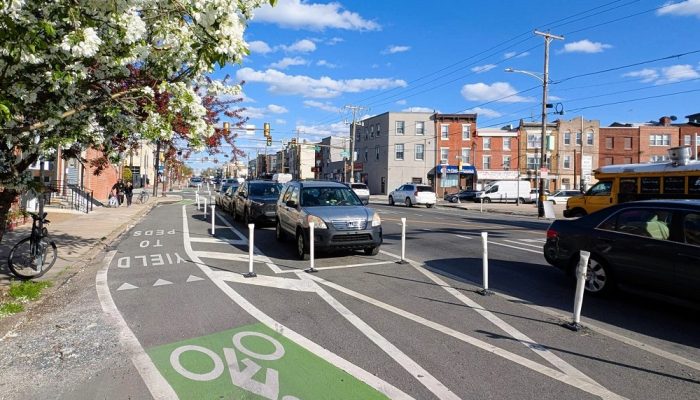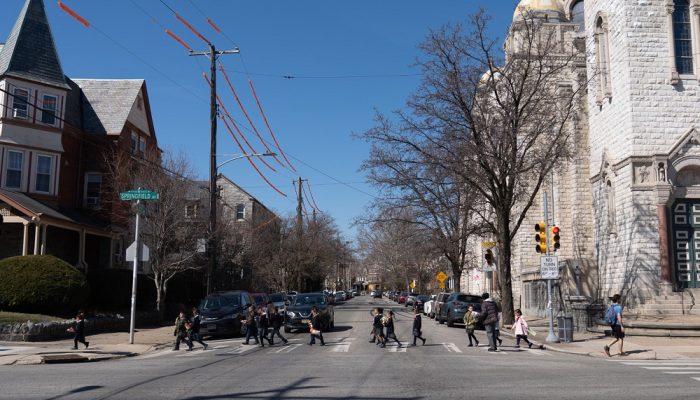In 2023, the City completed work on the Washington Avenue Repaving and Improvement project, which aimed to improve traffic safety and implement better curbside management, primarily between Broad Street and 4th Street. The Office of Transportation and Infrastructure Systems (OTIS) carried out the community engagement and design processes, while the Department of Streets oversaw the implementation.
The project was enabled by City Council legislation, which requires OTIS to complete project evaluation studies after each of the first two years following project implementation. You can read about the Year 1 Evaluation Report here.
The City is committed to accountability and uses a data-driven approach in these project assessments. The Washington Avenue Year 2 Evaluation Report will help us further understand how this project has impacted people walking, driving, taking transit, and riding bicycles along the corridor. This information will help us determine how well the project accomplished the goals and objectives discussed with residents and businesses during community engagement from 2019 to 2022. It will also provide updates on status of recommendations made in the Year 1 Evaluation Report.
Key Takeaways
Travel Times – No significant change in travel times along Washington Avenue
- On weekdays, eastbound travel times slightly decreased from pre-Implementation to Year 2; and westbound travel times generally increased by one to two minutes due to delays observed at the Broad Street intersection during the peak period.
Vehicular Volumes – No significant change in vehicle volumes along Washington Avenue
- On both weekdays and weekends, vehicular volumes have remained steady between Year 1 and Year 2. Volumes have not returned to pre-COVID and pre-implementation levels.
Bicycle Volumes – Bicycle volumes increased corridor-wide during the peak hours of weekday mornings and Saturdays, especially east of Broad Street
- On weekdays, annual average daily bicycle (AADB) volumes increased as much as 128% at certain locations from pre-implementation to Year 2.
Pedestrian Volumes – Pedestrian volumes at intersections along Washington Avenue increased from pre-Implementation to Year 2 during most peak hours
- On weekends, pedestrian volumes increased more on the east side of Broad Street versus the west side of Broad Street.
Speed – Speeds on Washington Avenue stayed at or below the posted speed limit, and off-peak speeding decreased
- In the Year 1 report, we found instances of off-peak speeding east of Broad Street. The City responded by adjusting traffic signal timing and as a result we are now seeing reduced speeding overall.
- We continue to see the effectiveness of speed cushions in reducing the percent of vehicles traveling above the speed limit on blocks where they are installed.
Recommendations & Next Steps
In the Year 1 report, recommendations were made to further improve parking and loading operations and traffic safety. The Year 2 report provides updates for these recommendations and provides a few new traffic safety recommendations.
The City is continuing to improve and evaluate Washington Avenue in multiple ways, including:
- Bus boarding islands will be installed on Washington Avenue east of Broad Street. Construction is anticipated to begin in 2026.
- The Washington Avenue Connector project will begin construction spring/summer 2025. This project will provide safe bicycle and pedestrian access from 4th Street across Columbus Boulevard to the Delaware River Trail.
- The City will continue monitoring the operations and safety of Washington Avenue and will release 3- and 5-year crash analyses, comparing before and after data, when sufficient data is available to do so.
What About Crash Data?
We need sufficient crash data to perform a meaningful crash analysis for any project. Even then, standard best practice is to use at least three years of data to avoid issues related to small data sets.
Construction on Washington Avenue was completed on March 1, 2023. As of today, PennDOT crash data is only available through December 31, 2023. The City plans to release 3-year and 5-year before and after crash analysis when sufficient data is available to do so.




